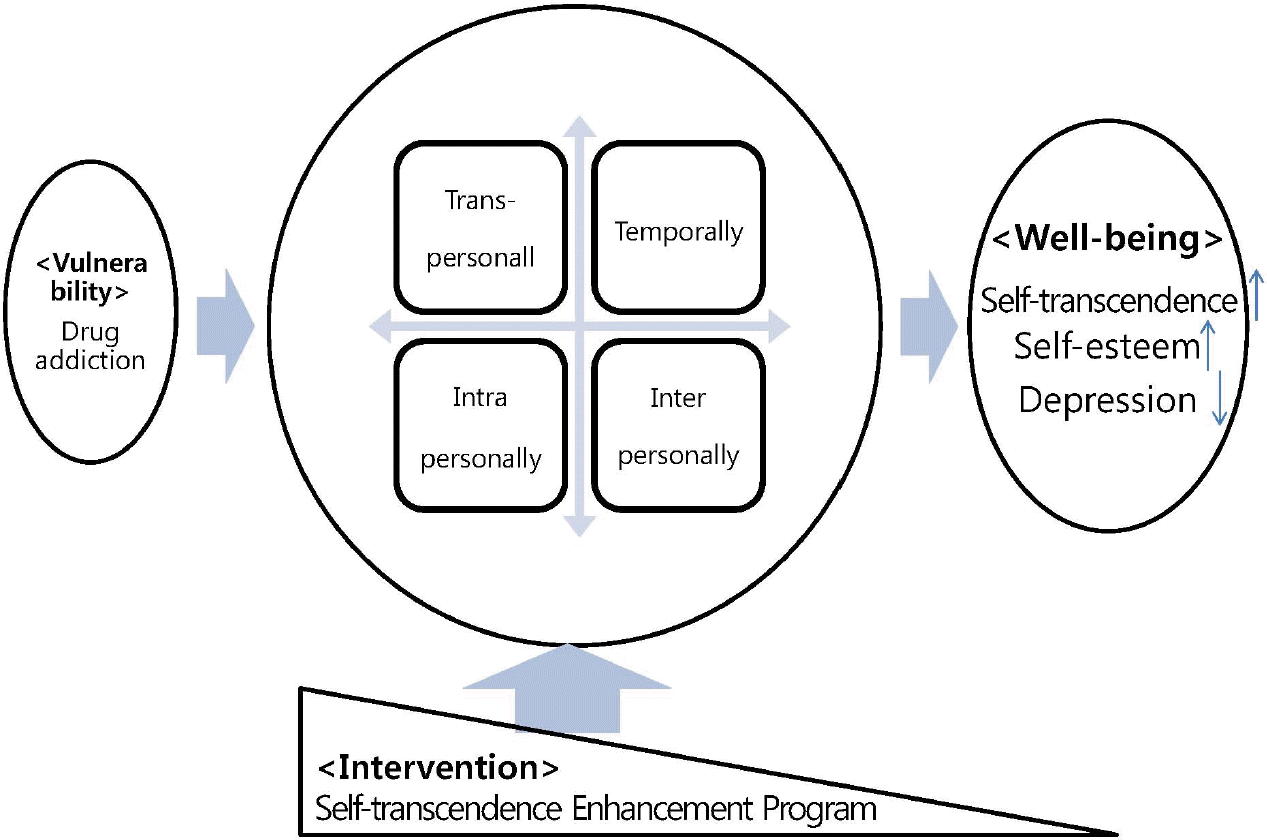Abstract
Purpose
The purpose of this mixed method study was to examine effects of the self-transcendence enhancement program among patients with drug addiction, and to explore their experiences through the program.
Methods
For the quantitative study, a non-equivalent control group quasi-experimental design was used. The sample was 49 hospitalized patients with drug addiction. The self-transcendence enhancement program was provided twice a week for 6 weeks. Quantitative data were analyzed using x2 test, t-test and ANCOVA. For the qualitative study, 12 patients in the experimental group participated in a focus group interview, and data were analyzed using the content analysis technique.
Results
After the intervention, there were significant improvements for the experimental group in self-transcendence and declines in depression compared to the control group. From the qualitative findings three themes were identified as the change process after the intervention: ‘looking back at myself’, ‘gaining confidence through small changes’, and ‘finding meaning in life’.
Go to : 
REFERENCES
1. Supreme Public Prosecutors' Office. A white paper on drugs crime 2015 [Internet]. Seoul: Supreme Public Prosecutors' Office;2016. [cited 2005 Aug]. Available from. http://www.spo.go.kr/spo/major/drug/data/drugbbs04.jsp.
2. World Drug Report 2013-by United Nations Office on Drugs and Crime. 2014; 33(2):1–216. https://doi.org/10.1111/dar.12110.
3. Kim BS, Kim HB. The new paradigm to the addiction crime. Journal of Korean Association of Addiction Crime. 2011; 1(1):89–113.
4. Urbanoski K, Kenaszchuk C, Veldhuizen S, Rush B. The clustering of psychopathology among adults seeking treatment for alcohol and drug addiction. Journal of Substance Abuse Treatment. 2015; 49:21–26. https://doi.org/10.1016/j.jsat.2014.07.004.

5. Watkins KE, Hunter SB, Hepner KA, Paddock SM, de la Cruz E, Zhou AJ, et al. An effectiveness trial of group cognitive behavioral therapy for patients with persistent depressive symptoms in substance abuse treatment. Archives of General Psychiatry. 2011; 68(6):577–584.

6. Sorensen T, Lien L, Landheim A, Danbolt LJ. Meaning-making, religiousness and spirituality in religiously founded substance misuse services-A qualitative study of staff and patients’ experiences. Religions. 2015; 6(1):92–106. https://doi.org/10.3390/rel6010092.
7. Heo G. Alcoholism and spiritual recovery of spiritual disease. Studies on Life and Culture. 2004; 6:1–10.
8. Joe YO. A study of healing relation addiction. Theology and Praxis. 2014; 38:409–440. https://doi.org/10.14387/jkspth.2014.38.409.

9. Park SG. The development and effectiveness of a self-love program for the treatment of drug abusers. The Korean Journal of Clinical Psychology. 2002; 21(4):693–703.
10. Kim HK, Lee MH. Effectiveness of forgiveness therapy on resilience, self-esteem, and spirituality of wives of alcoholics. Journal of Korean Academy of Nursing. 2014; 44(3):237–247. https://doi.org/10.4040/jkan.2014.44.3.237.

11. Kang SJ, Kim SJ. Effects of forgiveness therapy program on self-esteem, anger, and forgiveness in people who abuse alcohol. Journal of Korean Academy of Psychiatric and Mental Health Nursing. 2015; 24(4):300–309. https://doi.org/10.12934/jkpmhn.2015.24.4.300.

12. Orbon M, Mercado J, Balila J. Effects of forgiveness therapy on recovery among residents of drug rehabilitation centers. Pro-cedia - Social and Behavioral Sciences. 2015; 165:12–20. https://doi.org/10.1016/j.sbspro.2014.12.599.

13. Bowen S, Witkiewitz K, Kclifasefi SL, Grow J, Chawla N, Hsu SH, et al. Relative efficacy of mindfulness-based relapse prevention, standard relapse prevention, and treatment as usual for substance use disorders: a randomized clinical trial. Journal of the American Medical Association Psychiatry. 2014; 71(5):547–556. https://doi.org/10.1001/jamapsychiatry.2013.4546.
14. Park SG. The 48 step Happiness Program in the drug addiction treatment. Ministry of Justice a Service Report. Gongju, Institute of Forensic Psychiatry Ministry of Justice. 2011. Report No. 11-1270241-000007-01.
15. Kim SS, Reed PG, Kang YM, Oh JN. Translation and psychometric testing of the korean versions of the spiritual perspective scale and the self-transcendence scale in korean elders. Journal of Korean Academy of Nursing. 2012; 42(7):974–983. https://doi.org/10.4040/jkan.2012.42.7.974.

16. Kim MR. Moderating effect of spirituality in the relationship between self-focused attention and depression. Korean Journal of Religious Education. 2014; 44:21–44.
17. Cho JH, Son CN. Effects of the mindfulness-based cognitive therapy (MBCT) program on depression, impulsivity, and drug abstinence self-efficacy of drug addicts. The Korean Journal of Clinical Psychology. 2013; 32(1):13–31. https://doi.org/10.15842/kjcp.2013.32.1.002.
18. Lim YJ. Efficacy of positive psychotherapy on college students with major depressive disorder. Korean Journal of Clinical Psychology. 2012; 31(3):679–692. https://doi.org/10.15842/kjcp.2012.31.3.003.
19. Jang YH, Kwon MG. A research about spiritual program influence upon the anxiety and depression of women going through their menopause. Journal of Digital Convergence. 2014; 12(4):437–442. https://doi.org/10.14400/jdc.2014.12.4.437.

20. Otaka K, Shimai S, Tanaka-Matsumi J, Otsui K, Fredrickson BL. Happy people become happier through kindness: A counting kindness intervention. Journal of Happiness Studies. 2006; 7(3):361–375. https://doi.org/10.1007/s10902-005-3650-z.
21. Kwon KI, Yang JY. Trends in mixed methods research in counseling. CNU Journal of Educational Studies. 2014; 35(1):103–124. https://doi.org/10.18612/cnujes.2014.35.1.103.
22. Huh J. The Right sample size using IBM SPSS sample power. Seoul: Hannarau Academy;p. 90.
23. Jon BJ. Self-esteem: A test of its measurability. Yonsei Medical Journal. 1974; 11:109–129.
24. Cho MJ, Kim KH. Diagnostic validity of the CES-D (Korean version) in the assessment of DSM-III-R major depression. Journal of the Korean Neuropsychiatric Association. 1993; 32(3):381–399.
25. Mitrovic M, Hadzi-Pesic M, Stojanovic D, Milicevic N. Personality traits and global self-esteem of alcohol addicts. Procedia - Social and Behavioral Sciences. 2014; 127:255–259. https://doi.org/10.1016/j.sbspro.2014.03.251.

26. Park JH. A Review of forgiveness psychological theory and education program. The Korean Journal of Human Development. 2006; 13(1):117–134.
27. Baik HU, Han IY. The recovery experience of drug addicts in a community - the regeneration in the real world. Mental Health & Social Work. 2014; 42(3):151–177.
Go to : 
Table 1.
Self-Transcendence Enhancement Program
Table 2.
Homogeneity of General Characteristics and Dependent Variables (N=49)
Table 3.
Differences in Dependent Variables between Experimental and Control Groups (N=49)
| Variables | Groups | Pretest | Posttest | t or F∗ | p |
|---|---|---|---|---|---|
| M±SD | Posttest M±SD | ||||
| Self-transcendence | Exp. (n=24) | 42.04±4.21 | 45.04±4.87 | 3.33 | .002 |
| Cont. (n=25) | 42.04±4.84 | 41.64±4.73 | |||
| Self-esteem | Exp. (n=24) | 28.04±4.97 | 29.88±4.73 | 1.41∗ | .241 |
| Cont. (n=25) | 30.68±4.14 | 30.48±6.09 | |||
| Depression | Exp. (n=24) | 17.21±10.11 | 13.75±9.80 | −2.96 | .005 |
| Cont. (n=25) | 16.08±13.03 | 17.48±12.88 |
Table 4.
Sub-categories, Categories, and Themes




 PDF
PDF ePub
ePub Citation
Citation Print
Print



 XML Download
XML Download